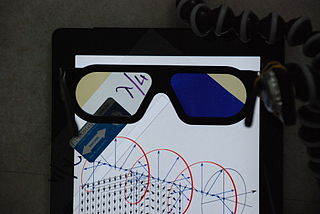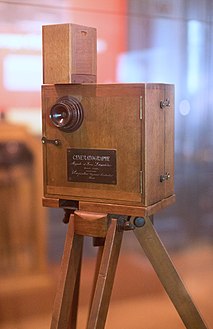

Teleview was a system for projecting stereoscopic motion pictures invented by Laurens Hammond, [1] best known as the inventor of the Hammond organ. It made its public debut on 27 December 1922 at the Selwyn Theatre in New York City, the only theater ever equipped with the system. The program included several short films, a live presentation of projected 3D shadows, and the 95-minute feature film M.A.R.S. (or The Man From M.A.R.S. ), later re-released in 2D as Radio-Mania.
A three-dimensional stereoscopic film is a motion picture that enhances the illusion of depth perception, hence adding a third dimension. The most common approach to the production of 3D films is derived from stereoscopic photography. In this approach, a regular motion picture camera system is used to record the images as seen from two perspectives, and special projection hardware or eyewear is used to limit the visibility of each image to the viewer's left or right eye only. 3D films are not limited to theatrical releases; television broadcasts and direct-to-video films have also incorporated similar methods, especially since the advent of 3D television and Blu-ray 3D.

Laurens Hammond, was an American engineer and inventor. His inventions include, most famously, the Hammond organ, the Hammond clock, and the world's first polyphonic musical synthesizer, the Novachord.

The Hammond organ is an electric organ, invented by Laurens Hammond and John M. Hanert and first manufactured in 1935. Various models have been produced, most of which use sliding drawbars to specify a variety of sounds. Until 1975, Hammond organs generated sound by creating an electric current from rotating a metal tonewheel near an electromagnetic pickup, and then strengthening the signal with an amplifier so it can drive a speaker cabinet. The organ is commonly used with, and associated with, the Leslie speaker.
Contents
Teleview pioneered the alternate-frame sequencing method of stereoscopic 3D projection. The basic principle had been patented as early as 1897, but the improved Teleview implementation was the first to be presented to the public.
Left-eye and right-eye films were run through a pair of interlocked projectors with their shutters operating out of phase. Each shutter was three-bladed, so that each pair of film frames was projected three times (i.e., left-right-left-right-left-right) before the mechanisms moved the next pair of frames into position. At the minimum 16-frames-per-second silent film projection speed, this resulted in a minimum of 48 flashes per second per eye, eliminating the severe flicker that fatally flawed earlier systems in which the left-eye and right-eye frames alternated on a single strip of film projected at twice the normal rate.
Each theater seat was equipped with an attached viewing device supported by a gooseneck stand. It contained a rotary shutter synchronized with the projector shutters, so that each of the user's eyes saw only the images intended for it. Persistence of vision made both views appear to be uninterrupted and a normal fully stereoscopic image was seen.

Persistence of vision traditionally refers to the optical illusion that occurs when visual perception of an object does not cease for some time after the rays of light proceeding from it have ceased to enter the eye. The illusion has also been described as "retinal persistence", "persistence of impressions", simply "persistence" and other variations. According to this definition, the illusion would be the same as, or very similar to positive afterimages.
Hammond's system won praise, but because of the high cost of installing the equipment, and the inconvenience of having to peer through the unwieldy viewer, it disappeared completely after this lone engagement ended in early 1923. [2]
The alternating image method enjoyed a revival after the advent of optoelectronic shutters in the 1970s made it more practical. Modern LC shutter glasses are used for viewing projected 3D films in some theaters, as well as 3DTV video and stereoscopic computer graphics.
Optoelectronics is the study and application of electronic devices and systems that source, detect and control light, usually considered a sub-field of photonics. In this context, light often includes invisible forms of radiation such as gamma rays, X-rays, ultraviolet and infrared, in addition to visible light. Optoelectronic devices are electrical-to-optical or optical-to-electrical transducers, or instruments that use such devices in their operation. Electro-optics is often erroneously used as a synonym, but is a wider branch of physics that concerns all interactions between light and electric fields, whether or not they form part of an electronic device.











